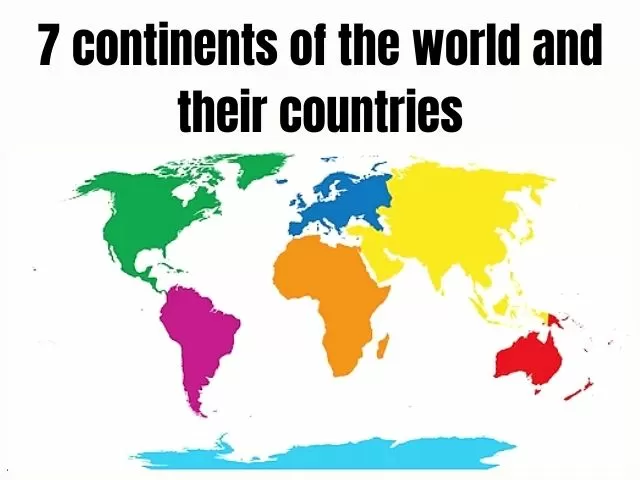7 continents of the world: The Earth consists of 71% and 29% of landmasses. These land masses are further divided into continents. The complicated geological process of plate tectonics led to the formation of continents. It starts when the Earth's surface-level lithospheric plates move and interact. When these plates contact and exert enormous pressure, the Earth's crust can bend and fold, resulting in the formation of continents.
Over the course of millions of years, this process resulted in the elevation and creation of substantial landmasses, which eventually gave rise to continents. There are a total of 7 continents in the world, Asia, Africa, Europe, North America, South America, Oceania and Antarctica.
What is Government Shutdown in the US? Know What is Open And What Stay Closed?
Let us take a look at each of these continents and their countries.
1. Asia
It is the largest continent in the world both in terms of area and population. It comprises 48 nations and 60% of the world's population.
Spanning over an area of 44,579,000 sq. km., the continent borders the Pacific Ocean in the east, the Arctic Ocean in the north, the Indian Ocean in the south, and Europe to the west. The Ural Mountains separate it from Europe and the Sinai Peninsula & Red Sea separate it from Africa.
The continent houses the world's highest mountain ranges, and the two most populous countries, among other superlatives.
Also, Read | Russia is in which continent? Asia or Europe?
2. Africa
It is the second-largest continent in the world after Asia both by area and population. It comprises 54 countries and over 16% of the world's population.
The continent is spread over an area of 30,370,000 sq. km. and is bounded on the west by the Atlantic Ocean, on the north by the Mediterranean Sea, on the east by the Red Sea and the Indian Ocean, and on the south by the Atlantic and Indian oceans.
All three latitudes-- the Equator, Tropic of Cancer, and Tropic of Capricorn pass through Africa.
3. North America
It is the third-largest continent on the Earth in terms of area and fourth-largest in terms of population. It comprises 23 nations and is entirely located in the northern hemisphere.
The continent extends over 24,709,000 sq. km. and is bordered by the Arctic Ocean in the north, the Atlantic Ocean in the east, the Pacific Ocean in the west, and South America to the south.
A very narrow strip Isthmus of Panama connects it with South America and the Bering Strait separates it from Asia.
4. South America
It is the fourth largest continent areawise and the fifth most populous in the world. It consists of 12 nations and mostly lies in the southern hemisphere while a small portion of the continent lies in the western hemisphere.
Spread over an area of 17,840,000, the continent is bordered by the Atlantic Ocean in the east, the Pacific Ocean in the west, the Southern Ocean in the south, and North America in the north.
The continent is home to the Amazon Rainforest, the lungs of Earth.
5. Antarctica
It is the fifth-largest continent on Earth with no countries and permanent human habitation. However, the continent has permanent human settlements where scientists and support staff live on a rotational basis.
Spanning over an area of 14,200,000 sq. km. the continent is completely surrounded by the Southern Ocean.
6. Europe
It is the sixth-largest continent in the world and the third most populous in the world. Europe and Asia are sometimes called Eurasia as they are physically connected but are considered separate continents due to linguistic and cultural differences. Europe comprises 48 countries.
The continent is bordered by the Arctic Ocean in the north, the Atlantic Ocean in the west, the Caspian Sea in the southeast, and the Mediterranean and Black Seas in the south. The Ural and Caucasus Mountains are the eastern boundary of Europe.
7. Australia
Australia is the smallest continent in the world and is the flattest and second driest after Antarctica. It is also the second least populated after Antarctica. It comprises 14 countries.
Spread over 8,525,989 sq. km., the region is also described as Oceania to differentiate it from a country by the same name. The place is a living laboratory. This is because when the continent started breaking away from Antarctica around 60 million years ago, it carried animals that developed into creatures unique to the region.
Interesting Facts About The Continents
- Asia is the birthplace of many major religions, including Buddhism, Hinduism, Islam, and Christianity.
- Africa is often called the "Cradle of Humankind" because it is believed to be the birthplace of modern humans.
- It is home to the world's third-largest river, the Mississippi-Missouri River System.
- Machu Picchu in Peru is one of the most iconic archaeological sites in the world.
- Antarctica is the coldest, driest, and windiest continent on Earth.
- The Antarctic Treaty, signed in 1959, designates Antarctica as a place for peaceful scientific cooperation and bans military activity.
- Europe has a dense railway network and is known for its efficient public transportation.
- Australia is home to the world's largest monolith, Uluru (Ayers Rock).
Explained: How did the earliest continents on Earth come into existence?
